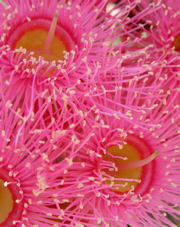Xenoestrogens Cause Hormone Imbalance
Xenoestrogens or chemical estrogens or synthetic estrogens or environmental estrogens cause hormone imbalance. Herbs can be phytoestrogens or
plant estrogens also contribute to loss of balance. The loss of balance is typically too much estrogen or Estrogen Dominance.
If these xenoestrogens and phytoestrogens are eliminated from the patient's environment, the Estrogen Dominance typically goes away. Topical progesterone cream
 may also be used to balance out and counter the effect
of too much estrogen, but only if the xenoestrogen load is not too much.
may also be used to balance out and counter the effect
of too much estrogen, but only if the xenoestrogen load is not too much.
Environmental estrogens and phytoestrogens pretend to be estrogen. They masquerade as estrogen. They fool the body into thinking that they are estrogen. However, they are not real estrogen and will not show up on the lab test. These synthetic chemicals were previously thought to be inert and are called xenoestrogens. Xeno means "foreign". Phytoestrogens are plant estrogens. These environmental estrogens are NOT carcinogenic. They are not allergenic. They are not toxic. These xenoestrogens are hormone disruptive. This new way of describing and classifying the chemicals has just been in forefront of scientific investigation since the early 90's. Since these chemical estrogens fool your body into thinking they are estrogen, your body sees too much estrogen and there is a hormone imbalance.
Xenoestrogens Are Bad For You
"Xeno" means "foreign". Thus, xenoestrogens is defined as "foreign estrogens". There are more than 100,000 different chemicals used in the United States, some just happen to have hormone effects. A hormonal effect is not toxic and is not necessarily oncogenic (cancer) effects. Loss of balance is not toxic effect and is not a carcinogenic effect; it is a "chemical messenger" effect. These xenoestrogens add to your own estrogen and cause you to have a imbalance. Hormone disruption has been recorded in the scientific literature from the 1950's. However, recently, there has been renewed interest in hormone disrupters from the 1990 until now. But there is a push back from industry that would not like you to know about hormone disrupters because of the medical liability. Most medical doctors have never heard of xenoestrogens. Xenoestrogens are not in their tool box. They have never heard of "chemical estrogens". They may also mistakenly believe that synthetic brand name progestins are the same as natural progesterone. This view is encouraged by the pharmaceutical industry. Synthetic estrogen is used by cattle ranchers to rapidly grow cattle. The European Union has banned American beef from coming into the European Union citing estrogen growth stimulation precisely for this reason. Ranchers purposely create a hormone imbalance to make the cattle grow faster, fatter, and retain water. I had one patient claim that she knew exactly how the cattle felt. The ranchers claim that the synthetic estrogen washes out of the body in several days. Opponents of the estrogenized beef claim that the synthetic estrogen is fat soluble and is stored in the fat. Pellets of estrogen inserted behind the cattle's ear for a slow release of estrogen. It is important to note that not all estrogen is created the same. Different kinds of estrogen have different effects.
Xenoestrogens or Environmental Estrogens are thought to cause endometriosis, endometrial cancer, premenstrual syndrome, precious puberty (premature puberty), breast cancer, ovarian cancer, menstrual migraines and breast cysts. There is Breast Cancer Fund white paper on Environmental Estrogens for download here.
Skeptics and proponents of companies that have a monetary interest in the xenoestrogen issue claim that xenoestrogens
 only have a "weak" stimulatory effect. They say people are worry warts.
Real Science says there is no effects of chemical estrogens. The problem is that their "Real Science" is "Junk Science" powered
by "Big Money".
only have a "weak" stimulatory effect. They say people are worry warts.
Real Science says there is no effects of chemical estrogens. The problem is that their "Real Science" is "Junk Science" powered
by "Big Money".
A hormone is a chemical messenger. The human body's hormones communicate at levels of parts per trillion. Remember a hormone is just a chemical messenger. This is about the same concentration of you spitting into an Olympic sized pool. Many of the chemicals that affect the systems are routinely found in blood samples after sauna at parts per billion. (Sauna helps to free the chemicals from the body fat and then go into the blood.) Simply, chemical hormone disrupters that affect the systems of the human body are found at 100 to 1000 times more concentration than that of the normal human hormones. So, even if these xenoestrogens are "weak" they are in the body at a 100 times more in concentration than the body's hormones.
Is it good for you? It can't be.
Critics of this theory of xenoestrogens that pooh pooh this say that plants contain many other phytoestrogens. So the chemical estrogens are of no consequence. This is a silly argument since all estrogens are NOT created equal. They all fit into the estrogen receptor, but they may affect the estrogen receptor differently. Some chemical estrogens may be blockers. Some may have partial estrogen effects. Some mave have funny estrogen effects (like creating breast cancer).
One scientist demonstrated that two "weak" estrogens act together synergistically to give a strong estrogen response. It is not just an additive response, it sometimes may be a multiplicative response. So not only do we have to test for individual xenoestrogen effect, it may be necessary to test for a combinatory effect. This becomes nearly impossible.
A classic Xenoestrogen like DDE discovered in the 1950's (a metabolite of DDT - an early pesticide) persists in the body fat for decades. Many of these xenoestrogens were previously thought to mainly occur in pesticides. But since the early 1990's, xenoestrogens are found in every day products used in the home. Innocuous chemicals such as lotions, shampoos, laundry detergents, spermicide on condoms, cosmetics, and even health herbs such as lavender and tea tree oil were found to be xenoestrogens and phytoestrogens. Yes, it is highly probable that environmental estrogens, xenoestrogens are causing breast cysts. The alternative medicine approach is to avoid xenoestrogens that cause the breast cysts.
Some information below credit given to Our Stolen Future by Theo Colborn:
DDT Pesticide
A published research investigation in the Proceedings of the Society of Experimental Biology and Medicine in 1950 by two Syracuse University Zoologists researchers Lindeman and Burlington demonstrated that DDT stopped young roosters from developing into normal roosters. For a period of 2-3 months, researchers injected forty young roosters with DDT. The daily injections of DDT did not kill the roosters. The roosters did NOT get sick. DDT injected created weird roosters; they resembled hens. The rooster's testicles were 18% of normal volume. Rooster combs and wattles were stunted and pale. These were DDT injected chemically castrated the roosters.
Micheal Fry, a specializing in wild life toxicology, at UCSD (University of California at Davis) injected sea gull
eggs DDT, DDE, (breakdown product of DDT),
and methoxychlor (another synthetic pesticide that binds to estrogen receptors). Fry found the male's reproductive tracts that became female. The testicles contained female cells.
 In gulls where higher doses of pesticide were injected, an oviduct was present. An oviduct is an egg-laying canal usually present in females only. Yet, for all this internal
disruption, the chick appeared to be superficially normal.
In gulls where higher doses of pesticide were injected, an oviduct was present. An oviduct is an egg-laying canal usually present in females only. Yet, for all this internal
disruption, the chick appeared to be superficially normal.
DDT binds to estrogen receptors. DDT is a classic xenoestrogens.
United States of America stopped DDT application use within its borders. But, DDT production world wide has never been higher. The United States makes and ships DDT to third world countries. DDT converts to DDE in the human body. The process takes several months. DDE then spends several decades stored in the body fat. Yet, some inquisitive medical doctors occasionally find DDT in the blood following intensive sauna. Where is this NEW DDT coming from? Third world countries purchase DDT from the USA. Then Third World countries use DDT on vegetables and fruits. These vegetables and fruit are shipped to USA and sold to you at a local supermarket. How about that? Americans eat the fruit and vegetable laden with DDT. In 1991, the United States sold 96 tons of DDT to other countries.
Another source of DDT may come from the soil near your house. If your house is near or built upon old agricultural land, DDT stays in the dirt for several hundreds of years. The houses built on the old cotton fields of Phoenix are famous for pesticides in the dirt that are easily absorbed into the homeowner's skin.
Plastics with Bisphenol-A and Nonlyphenol
At Tufts Medical School in Boston in 1987, Soto and Sonnenschein researchers stumbled on the discovery.
Plastic test tubes (thought to be inert) contained embedded in the plastic, a chemical estrogen that made breast cancer cells to replicate and proliferate. Soto and Sonnenschein experimented
with malignant breast cancer cells sensitive to estrogen. The breast cancer cells would replicate when exposed to estrogen. The breast cancer cells without estrogen would stop multiplying.

During their experiments, the test tube manufacturer changed the plastic test tubes composition. The manufacturer switched to p-nonylphenol one of the family of synthetic chemicals called alkylphenols to make these plastics making the test tubes less breakable. Manufacturers usually create their plastics with nonlyphenols with polystyrene and polyvinyl chloride (PVC). The new plastic test tubes caused the estrogen sensitive breast cancer cells to grow. Thus, Soto and Sonnenschein concluded that p-nonylphenol pretended to be like an estrogen.
One scientist demonstrated that the food processing industry and packaging industry used PVC's that contained nonlyphenols. Another reported contamination of water that had passed through PVC tubing. Even compounds found in contraceptive creams nonoxynol-9 breaks down inside the animal's body to produce nonylphenol. Breakdown of chemicals such as those found in industrial detergents, pesticides, and personal care products give rise to nonylphenol. Global production of alkylphenols polyethoxylate was 600 million pounds in 1990. Although the products purchased by the consumer are not themselves estrogenic; studies have found that bacteria in the animal's bodies, in the environment, or in sewage treatment plants degrade these alkylphenol polyethoxylates, creating nonylphenol and other xenoestrogens. Anecdotally, my severe endometriosis patients suspect that spermicide on condoms makes their endometriosis worse. Choose a condom without spermicide at Wal-Mart.
Plastic Drinking Receptacles and Plastics Food Containers
In 1993, at Stanford University School of Medicine, Dave Feldman, professor of medicine ran an experiment with a yeast estrogen protein that sticks to estrogen. Feldman discovered that polycarbonate bottles used for drinking water contained bisphenol-A. (See the article here Canada bans Polycarbonate drinking bottles because of BPA). The polycarbonate lab flasks used to sterilize the water used in their experiments contained Bisphenol-A. Bispheol-A nicely bound to the estrogen protein found in the yeast. The same polycarbonate plastic is routinely used for the giant jugs used to ship water.
The manufacturer knew that the bottles would leach particularly when exposed to high temperatures and caustic cleaners. The manufacturer designed a washing procedure that they thought would solve BPA leeching. However, the Stanford researchers discovered that the manufacturer could not detect Bisphenol-A samples sent from their lab. Those particular samples that were responsible for replication of estrogen responsive breast cancer cells. Why? There was a detection lower limit in the manufacturer's lab equipment. The Stanford research group discovered 2-5 parts per billion of bisphenol-A was strong enough to help the breast cancer cells to replicate and multiply.
Plastic bottles filled with drinking water will leach into the water if kept in a hot car. These leached out chemicals may be causing a hormone imbalance.
Professor Feldman has agreed that bisphenol-A is two thousand times (2000X) less strong than estrogen, "it still has activity in the parts per billion range."
"Bisphenol-A is 2000X less potent than estrogen, but still has activity in the parts per billion range."
Professor Feldman
One Dartmouth University Study showed that plastic wrap warmed in a microwave oven with vegetable oil had 500,000 times the minimum amount of chemical estrogens (xenoestrogens) required to make breast cancer cells to grow in a test tube.
One patient of mine skipped all the xenoestrogens that she could. She felt better. She then had a momentary lapse, and heated her food on a plastic plate. She claimed that she could feel herself bloat with a hormone imbalance after eating food from the heated food with the heated plastic.
In 2008, Canada banned Bisphenol A in plastic bottles. Wal-Mart voluntarily pulled all plastic drinking bottles that contained Bisphenol A. The FDA however, seems not convinced about the dangers of BPA Bisphenol A. Bisphenol A would cause an imbalance.
Canada bans plastic bottles with Bisphenol-A. See the article here.
Detergent Breakdown Chemicals
John Sumpter a biologist in Uxbridge, Brunel University, found male fish that looked like females as told by fisherman in English rivers. Fish angled from the pools downstream from the discharge of sewage plants looked unusual. Experienced fisherman could not tell if a fish was male or female. The fish demonstrated both male and female characteristics simultaneously. They were quintessential examples of hermaphrodite fish where an individual fish appear to be between both sexes.
Sumpter used a marker that could testify that a fish was female. Normally, in females a special egg protein is created called vitellogenin.
Vitellogenin is reactive to estrogen from the ovaries. Estrogen from the ovaries signals the liver to make vitellogenin. The protein vitellogenin
is put into the eggs. Because this action is dependent on estrogen, vitellogenin levels found in male fish would be a good indicator of estrogen exposure.

Caged fish kept in captivity were then transferred to the contaminated pools. These contaminated fish produced 1000X to 100,000X more vitellogenin than control trout kept in clean water.
15 sites were sampled that showed huge vitellogenin levels showing a national English problem. Alkylphenol levels from detergent breakdown products are highly suspect. Yet, Sumpter believes that the synergistic action of several xenoestrogens acting together is causing the half male and half female fish.
In 2004, 42% of male bass living in the Potomac river near Washington DC are producing eggs. Researchers believe hormonal disrupting chemicals in the water are causing male bass to be female.
A similar study that found feminized male White Sucker fish below a sewage treatment plant swimming in the Colorado Platte River. As of 2004, little is done to test for these chemicals -- either in river water or in drinking water. The U.S. Environmental Protection Agency has not set standards. The EPA claims more research is needed to determine which contaminants are harmful and what levels are unsafe.
In 2009, the USGS (see below) found half male and half female fish in every watershed in the United States. The gender confused fish are found below the sewage outfall. Where does the sewage come from? It comes from your house! Chemicals in your home are feminizing fish and are giving you hormone imbalance.
Canned Foods
Two Spanish Scientists at the University of Granada studied the plastic coatings that sprayed into metal cans. The coating stops the taste of metal in the food from the cans. 85% of the cans have these plastic coatings. Fatima Olea and Nicolas Olea an M.D. specializing in endocrine cancers worked with Soto and Sonnenschein. In a study with twenty brands of canned foods purchased in the United States and in Spain, they discovered bisphenol-A. Bishphenol-A is the same chemical that the Stanford researchers found. Bisphenol-A was in about half of the canned food up to levels of 80 parts per billion. The concentration is 27 times greater concentration of bisphenol-A needed to cause the breast cancer cells to replicate in the Stanford Study.
Commercially raised Beef and Sheep
Cattle are farmed in the United States by using synthetic estrogens to fatten them up and make them to retain water.
This creates bigger profits for the rancher. It is a cheap and fast method to fatten them up. In the 1970's and 1980's
there was a large population in Puerto Rico of early puberty in girls as young as a year old and even young boys
that developed breasts caused by meat and dairy products containing high levels of estrogen. In the United States,
the use of estrogen compounds is now slightly better regulated, but it is still very much used and abused.
Now, federal regulations allow these chemical messengers to be used on growing cattle and sheep,
but not on poultry (chickens, turkeys, ducks) or hogs (pigs). Ranchers purposely create
a imbalance in their cattle for fatter profits. Fatter profits, fatter cattle, and fatter humans
are the result of imbalance caused by xenoestrogens.

DES (diethylstilbesterol), a type of synthetic estrogen, was the first hormone to be used by the meat industry to fatten up livestock until it was found that it causes cancer even in extremely minute amounts. Birth defects such as misshapen uteri are common in women whose mothers were exposed to DES during pregnancy.
Birth Control Pills
Birth Control Pills has a synthetic estrogen and a synthetic progesterone to require the body to cycle in a normal manner even though conception may have occurred. Some research pharmacists claim that birth control pills may act as a abortifacient. Different hormonal levels are supposed to occur. Adding extra estrogen to a women's body may exacerbate breast cysts. Recently, it was found that breast cancer is caused by synthetic estrogens and now a major pharmaceutical company is facing many law suits.
Why not use a simpler method of birth control such as condoms? Use one that does not use a spermicide such as nonoxynol-9. Researchers showed that nonoxynol-9 gets into a rats body and breaks down into nonylphenol - a known xenoestrogen.
Preservative Paraben - butyl paraben, propyl paraben, methyl paraben, ethyl paraben in Skin Lotions and Gels
For many years, Parabens were considered to be one of those preservatives with low systemic toxicity. Previously, it was thought that the only draw back to Parabens were allergic reactions. However, parabens pretend to be and mimic estrogen. Hormonal disruption was never considered, only toxicity, carcinogenicity, and allergenic reactions. Now, John Sumpter from the Department of Biology & Biochemistry, Brunel University, Uxbridge, Middlesex, has found that alkyl hydroxy benzoate preservatives (namely methyl-, ethyl-, propyl-, and butylparaben) are weakly estrogenic. In an estrogen receptor-binding assay, butylparaben was able to compete with estradiol for binding to estrogen receptors with an affinity approximately 5 orders of magnitude lower than that of diethylstilbestrol (a highly carcinogenic synthetic estrogen), and between 1 and 2 orders of magnitude less than nonylphenol (an estrogenic synthetic industrial chemical).
Taken orally, the parabens were inactive. But subcutaneous (below the skin) administration of butylparaben
produced a positive estrogenic response on uterine tissues. Although 100,000 times less potent than17 beta-estradiol,
more exposure to the parabens may compensate for their lower potency. The researchers conclude, "Given their use in a
wide range of commercially available topical preparations, it is suggested that the safety in use of these chemicals should be reassessed . . ."

The European Union asked the European Cosmetics and Toiletry industry about the result of these new studies and the implications for breast cancer. These preservatives are found in most of skin and body lotions, even in natural progesterone creams. Generally, for the steroid hormonal system, taken orally, the chemical messengers are 90% first pass metabolized inactivated by the liver and this 90% does not reach the body. Taken orally, only 10% reaches the body. In contrast, anything absorbed by the skin is directly absorbed and bypasses the liver. In other words, anything put on and absorbed by the skin may be as high as 10 times the potency of an oral dose.
In my clinical experience, if you can get the endometriosis patients to stop parabens on their skin alone without doing anything else, the endometriosis patients will feel much better after 2 months. Endometriosis patients are the classic hormone imbalanced patients having too much estrogen. Be VERY careful about what goes on the skin.
So your skin lotion that contains parabens is causing your imbalance.
Unfortunately, some natural progesterone creams were found to contain methyl and propyl parabens as a preservative. The preservative may masquerade under a different name such as brand name that contains these parabens. A fast web search may reveal this possible charade.
The 327 page Danish government study (see below) implicates parabens as feminizing chemicals causing loss of balance.
Shampoos that Purposely Contain Very High Amounts of Estrogen
African Americans may prefer to use shampoos with clinically active high doses of estrogen. They also used them on their children. In 1998 Tiwary, now retired, published a study of four girls - including a 14-month-old - who developed breasts or pubic hair months after beginning to use such products fortified with estrogen. The symptoms began to disappear when they finished using estrogen fortified products. The year before, he published a study demonstrating that products patronized by his patients had up to one milligram (1 mg) of estradiol per one ounce of shampoo. By comparison a normal adult topical skin dose for estradiol is 0.02-0.05 mg/day. This means that one ounce of shampoo contains 50 times the daily ADULT dose of estradiol. A small handful of this shampoo on your child every day may give her OR HIM breasts! Shampoo contains active effective clinical doses of estrogen. See the article here.
Herbicide Atrazine Feminization
Tyrone B. Hayes of the University of California at Berkeley showed that atrazine, the most commonly used weed killer in North America, affected frogs at doses as small as 0.1 part per billion. As the amount of atrazine increased, about 20 percent of frogs exposed to atrazine during their early development produced multiple sex organs or had both male and female organs. Many had small, feminized larynxes.
Herbicide causes feminization of frogs. See the article here.
Plastic IV Bags
The United States FDA warns that prolonged fluid exposure in IV bags may affect testicle development in young boys. The chemical, called DEHP, may leach from the plastic into certain liquids, especially fat-containing ones like blood. Young animals studies show the chemical can affect testicle development and production of normal sperm. Some companies already label that their products contain phthalates (DHEP). The FDA soon will issue a recommendation, not a requirement, that more companies label their products that contain phthalates.
"FDA's public health notification falls far short of what is needed to protect patients," said Charlotte Brody of Health Care Without Harm, a group working to reduce the amount of phthalates, the family of chemicals that includes DEHP, in a variety of products, from plastic toys to cosmetics.
IV bags leech DEHP promoting feminization. See the article here.
Estrogenic Sunscreen - 5 Out of 6 Chemicals Used to block UV in Sunscreen are Estrogenic
Margaret Schlumpf and her colleagues (Institute of Pharmacology and Toxicology, University of Zurich, Switzerland) finds that many widely-used sunscreen chemicals pretend and mimic the effects of estrogen and trigger developmental abnormalities in rats. (Schlumpf , Margaret; Beata Cotton, Marianne Conscience, Vreni Haller, Beate Steinmann, Walter Lichtensteiger. In vitro and in vivo estrogenicity of UV screens. Environmental Health Perspectives Vol. 109 (March 2001) pp 239-244) Margret's research group studied six common chemicals that are used in sunscreens, lipsticks and facial cosmetics.
 Five of the six tested chemicals (benzophenone-3, homosalate, 4-methyl-benzylidene camphor (4-MBC), octyl-methoxycinnamate and octyl-dimethyl-PABA)
behaved like strong estrogen (do NOT stimulate estradiol, they pretend to be estradiol) in lab tests and caused
cancer cells to grow more rapidly. Only one chemical - a UVA protector called butyl-methoxydibenzoylmethane (B-MDM)
- showed no activity.
Five of the six tested chemicals (benzophenone-3, homosalate, 4-methyl-benzylidene camphor (4-MBC), octyl-methoxycinnamate and octyl-dimethyl-PABA)
behaved like strong estrogen (do NOT stimulate estradiol, they pretend to be estradiol) in lab tests and caused
cancer cells to grow more rapidly. Only one chemical - a UVA protector called butyl-methoxydibenzoylmethane (B-MDM)
- showed no activity.
"That was scary, because we used concentrations that are in the range allowed in sunscreens," stated Schlumpf.
Uterine growth is linked to endometriosis. One very common sunscreen chemical, 4-MBC, was mixed with olive oil and applied to rat skin. 4-MBC caused a doubling of the rate of uterine growth well before puberty. "That was scary, because we used concentrations that are in the range allowed in sunscreens," stated Schlumpf. Three of the six common chemicals in sunscreen caused developmental abnormalities in animals. The major cause of sterility in women in the USA is endometriosis, a condition afflicting 5.5% of American women. Exposure to excessive estrogen is felt to be the primary cause of endometriosis. One source of these xenoestrogens is sunscreen. Perhaps a sunscreen using zinc oxide is a better choice.
The vast majority of my patients that use sunscreen regularly experience bloating and breast tenderness just before their period which is the hall mark of Estrogen Dominance (too much estrogen).
Plastics chemical (Bisphenol A) harms eggs in gestating unborn mice
Female mice with and exposure to Bisphenol A, a common chemical found in plastics, while in the uterus develop abnormal eggs. Based on this study, researchers speculate that the chemical, bisphenol A, may or may not increase the risk of spontaneous abortion and genetic disorders in humans, such as Down's syndrome.
Bisphenol A, or BPA, is commonly found in hard plastics and the lining of tin cans. The chemical has come under
scrutiny before because it can mimic (pretend to be) estrogen. BPA can fit imperfectly in the estrogen
receptor somewhat mimicking estrogen but having a different effect.

Patricia Hunt at Washington State University in Pullman, US, and colleagues gave pregnant mice 20 micrograms of BPA per kilogram of their bodyweight each day over a one-week period. During this same period, the reproductive cells of female mice developing inside in the womb begin a process of division known as meiosis.
Bisphenol-A creates birth defects in mice eggs. See the article here.
Canada bans BPA. Read about it here.
Phthalates in Air Fresheners cause Hormone disruption
Studies involving rat and human subjects suggest that high exposures to certain kinds of phthalates may cause cancer, developmental and sex-hormonal abnormalities (including decreased testosterone and sperm levels and malformed sex organs) in infants, and can affect fertility. Alternative medicine believes that these phthalates can also cause breast cysts. The U.S. Food and Drug Administration has no regulations on the use of phthalates. The FDA does not require the labeling of phthalate content on products. The FDA does not consider the quantities to which people are exposed to be harmful. Yet, other countries think not. In 2004, the European Union banned two types of phthalates in cosmetics and also bans the chemical in children's toys, as do 14 other countries. The first state bill to ban phthalates in children's toys in the U.S. is currently sitting on California governor Arnold Schwarzenegger's desk, and he is expected to sign it this week.
Air Fresheners have pthalates that cause hormonal disruption. See the article here.
Trace Pharmaceuticals in Drinking Water blamed for sexual mutation in Fish
For example:
• In a broad study still under way, fish collected in waterways near or in Chicago, Illinois; West Chester, Pennsylvania; Orlando, Florida; Dallas, Texas; and Phoenix, Arizona, have tested positive for an array of pharmaceuticals -- analgesics, antibiotics, antidepressants, antihistamines, anti-hypertension drugs and anti-seizure medications.
• That research follows a 2003 study in northern Texas, where every bluegill, black crappie and channel catfish researchers caught living downstream of a wastewater treatment plant tested positive for the active ingredients in two widely used antidepressants -- one of the first times the residues of such prescription drugs were detected in wildlife.
• In several recent studies of soil fertilized with livestock manure or with the sludge product from wastewater treatment plants, American scientists found earthworms had accumulated those same compounds, while vegetables -- including corn, lettuce and potatoes -- had absorbed antibiotics. "These results raise potential human health concerns," wrote researchers.
• Blood and liver samples of bull sharks in Florida's Caloosahatchee River, a nursery area for juvenile bullsharks and home to six wastewater treatment plants, are being tested for the presence of an array of medications this winter. Of the first ten sharks sampled, nine tested positive for the active ingredient in an antidepressant.
• And in Colorado's Boulder Creek, 50 of the 60 white suckers collected downstream of Boulder's wastewater treatment plant were female, compared to about half of them upstream.
Elsewhere in the world -- from the icy streams of England to the wild game reserves of South Africa -- snails, fish, even antelope, are showing signs of possible pharmaceutical contamination. For example, fish and prawn in China exposed to treated wastewater had shortened life spans, Pacific oysters off the coast of Singapore had inhibited growth, and in Norway, Atlantic salmon exposed to levels of estrogen similar to those found in the North Sea had severe reproductive problems.
These same trace pharmaceuticals may be causing loss of balance in women.
Danish Scientific Study Fingers Chemical Estrogens in Feminizing Boys
A few exposures to a high content of an endocrine-disruptor, such as that of [the phthalate] DBP in rubber clogs may result in a critical risk for the two-year-old.
The amounts that two-year-olds absorb from the [preservative] parabens propylparaben and butylparaben can constitute a risk for oestrogen-like disruptions of the endocrine system. This contribution originates predominantly from cosmetic products such as oil-based creams, moisturizing creams, lotions and sunscreen. See the article here.
These same chemicals are causing loss of balance in women.
US Government Agency finds Chemical Estrogens Feminizing Fish in all US Watersheds
Chemical pollution seems to be disrupting fishes' hormonal system, blurring the line between male and female.
In fact, a recent USGS study found the phenomenon in virtually every watershed in the country. And it's and not just bass. Some carp, catfish and sturgeon have the same odd make-up.
 Here is a very nice video made by Suzanne Snedeker, PhD at Cornell University
that talks about xenoestrogens in our environment causing breast cancer and
other female diseases. She and her students have made a simple painless
video to watch. The video talks about the dangers of chemicals that mimic estrogen.
This should be required watching for all teenagers.
Here is a very nice video made by Suzanne Snedeker, PhD at Cornell University
that talks about xenoestrogens in our environment causing breast cancer and
other female diseases. She and her students have made a simple painless
video to watch. The video talks about the dangers of chemicals that mimic estrogen.
This should be required watching for all teenagers.